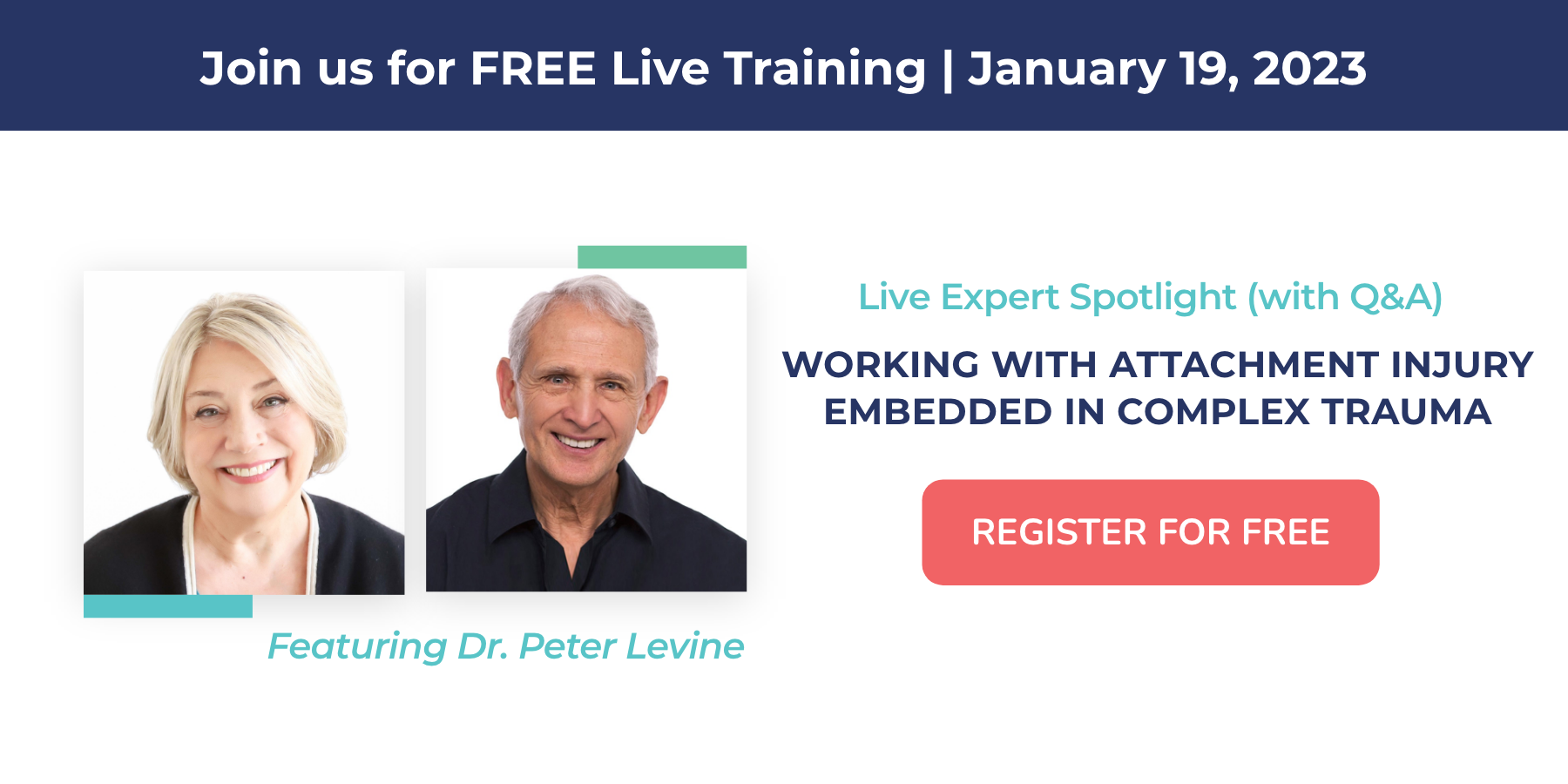Working with Attachment Injury Embedded in Complex Trauma w/ Dr. Levine
FREE ONLINE - 90 MINUTES - LIVE & RECORDED
Hosted by Dr. Diane Poole Heller
FEATURING DEMO CASES
We’re delighted to share an invitation with you to attend a LIVE expert spotlight training event Working With Attachment Injury Embedded in Complex Trauma hosted by Dr. Diane Poole Heller, featuring Peter A Levine, PhD.
Complex trauma is often rooted in unresolved experiences from the past, where memories feel like they’re happening in the now making it particularly difficult to engage the logical mind when the body remains dysregulated.
If the brain can’t find a way to down-regulate this automatic response, the brain can get trapped in a default setting, where it continues to repeat the same unhealthy responses and patterns time and again.
For your clients with complex trauma rooted in attachment injury who present with a variety of symptoms, from psychological issues like anxiety, depression, anger and hopelessness to physical symptoms such as chronic pain, fatigue or digestive issues it can often feel like they’re on high alert 24-7-365.
So how can we support clients suffering from complex trauma, especially when they may present with wide-ranging, diverse symptoms related to developmental trauma?
With the right training and proven somatic techniques, it’s possible to detect physical and behavioral signs of attachment injury embedded within complex trauma to tap into the body’s innate wisdom, calm the nervous system and unlock a greater capacity for healing.
Mark your calendar and join live…
Working With Attachment Injury Embedded in Complex Trauma
Thursday, January 19, 2023
11 am PT / 12 pm MT / 2 pm ET
With a fuller understanding of how complex trauma forms and how our systems become dysregulated as a result, you’ll learn how to begin applying body-centered methods for processing and healing.
In this free, 90-minute LIVE training…
Get a glimpse at the transformative nature of Somatic Experiencing®, as Dr. Levine demonstrates clinical techniques using short examples from actual client sessions.
Learn how to recognize and identify insecure attachment patterning and what happens to our bodies and emotions when the threat response persists into adulthood.
Understand why complex traumas form and remain stored in the body, including ways to release locked trauma to restore secure attachment and support post-traumatic growth and resilience.
Dr. Levine will demonstrate how to become attuned to and read the physical signs of trauma so you can more safely and effectively address trauma that can’t be verbalized.
Whether you’re a seasoned Somatic Experiencing® therapist or just starting out, this is a rare opportunity to learn critical clinical skills in a LIVE training format from two top experts in trauma and attachment.
You’ll want to attend the live session, as Dr. Levine and Dr. Heller have set aside time to answer your questions at the end.
And if you can’t make it, please don’t worry - a replay recording will be sent out the next day to anyone who registers.
We hope to see you there!
*This program is geared towards healing practitioners.
This program is hosted by Diane Heller. Please click the link and contact her team with any questions.
Attachment Injury Embedded in Complex Trauma
Why is attachment injury inherent in all complex trauma?
Attachment injury and complex trauma are interrelated. One of the reasons is that many people with complex trauma did not have proper early co-regulation with their caregivers. As a result, they remain vulnerable throughout their lives until there is a repair. The good news is that repair is possible later in life through therapeutic support because successful co-regulation at any age builds deep inner resilience.
A fact of life is that some caregivers are struggling, distracted, neglectful, or abusive. Relationship issues, addiction, and societal or work stressors can limit their capacity to be fully present for the infant and child. Postpartum depression can also play a role through no fault of the mother. In addition, a parent's lack of positive mirroring from their own caregivers as a child is a form of generational trauma that can linger and be passed on. Processing attachment and complex trauma is not about blaming; instead, it is working towards restoring what was needed.
The freeze or collapse response is one sign that attachment injury may be causing a client's complex trauma. They can perceive the world as non-responsive or unsafe and adopt negative biases and maladaptive coping mechanisms. Mistrust of support and chronic isolation can perpetuate these dissociated patterns. With insufficient regulation and mirroring, the system gradually starts shutting down, producing core physiological dysregulation. As a result, the client may appear lifeless with low energy, lack of movement, pale skin, low or irregular heartbeat, and respiration issues, such as shallow-breathing or hyperventilation.
A developmental growth sequence is necessary for a child to develop fully into a healthy and supported existence. Examples of regulation techniques for infants and children are sucking, holding, rocking, soothing, positive mirroring, fun role play, and caregiver participation in the infant and child's inner world. It also includes setting limits and boundaries; avoiding toxic shame and the suppression of their intrinsic sensuality and sexuality.
In therapy, we re-negotiate this growth through co-regulation with positive mirroring, including showing excitement and connection to a client's experiences and building positive resources that spark joy. The therapist must engage in a way that builds inner resilience and a capacity for a client to foster healthy relationships with loved ones. This role is not implicit; it needs to be conscious and intentional with a capacity to embody and express secure attachment. In addition, when working with caregivers suffering from attachment wounds, practitioners can guide them toward a deeper connection with their own children.
Therapeutically, practitioners can use body-based attachment techniques practiced in Somatic Experiencing® (SE™) to restore what was missing. By supporting healthy Neuroception (neural circuits that distinguish whether situations or people are safe, dangerous, or life-threatening), we can help our clients move through the world safer and with more ease.
